
A celestial spectacle awaits us on Monday evening, as the seasonal “Blue Moon” will appear in the sky.
The newspaper reported that this rare combination, dubbed the “super blue moon,” occurs when the different cycles of the blue moon and the super moons in the calendar align. USA Today NASA's Noah Petro, Lunar Reconnaissance Orbiter Project Scientist.
The “blue moon” is expected to be visible at 6:26 p.m., according to CNN. When the moon is at its closest point to Earth, it can appear up to 14 percent larger and 30 percent brighter than when it is at its farthest point, about 250,000 miles (405,500 kilometers) from Earth.
When the moon's orbit brings it closer to Earth than usual, this cosmic combination is called a “supermoon.” This phenomenon occurs when the moon's orbit is at its closest point to Earth at the same time as the moon is full.
The absence of clouds can help appreciate the phenomenon, according to Shannon Schmuhl, director of the Abrams Planetarium at Michigan State University.
“It's bright enough that you don't need to go anywhere special,” she told CNN. “And it's possible to see it right after sunset.”
According to NASA, the next super blue moon will be visible in January 2037.





